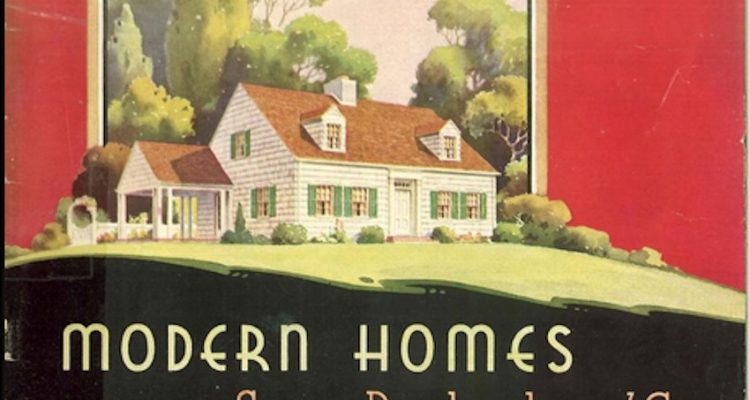Do you live in a Sears or Montgomery Ward house? Was your house built from a kit that was purchased through a mail-order catalog? Are you sure? From 1909 to 1940, Sears Robuck & Co. Sold over 90,000 houses through its mail order catalogs. That included over 400 home models. From 1909 through 1932, Montgomery Ward sold over 32,000 houses through its mail order catalogs. In addition, several smaller companies also sold house kits by mail order. One of those was Harris Brothers Homes in Chicago. Hundreds of kit homes are located in our region of the country. You may live in one of them and not even know it. The purpose of this document is to help you to learn more about the mail order kit houses and to help you to be able to determine if you live in one of them. Since Sears sold almost three times as many homes as Montgomery Ward and many times more than the smaller sellers of kit homes, this document will concentrate mostly on Sears homes. If you research Sears homes, you will find a variety of statements about how many Sears homes were built with estimates ranging from 50,000 to over 100,000. During the 1940’s Sears did some housekeeping at its headquarters and destroyed all of the records from the Sears home sales, so there is no way to know the exact number of house kits that they sold for sure.
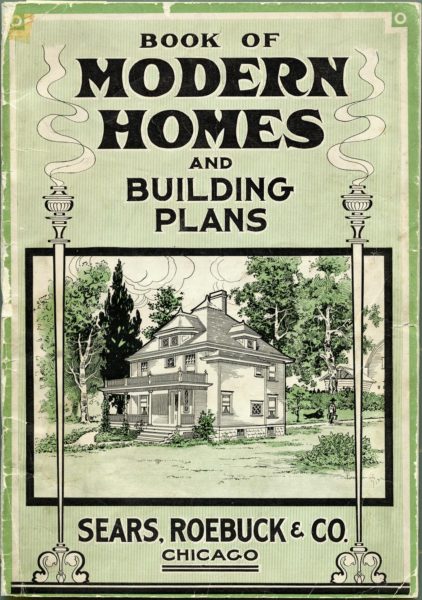
Sears Modern Homes Catalog 1908
Here is how it worked. Every year from 1908 to 1940, Sears published a catalog of houses for sale. The prospective homeowner would browse through the catalog and select the home that he or she wanted to order. Financing was not a problem. The catalog stated, “We have everything you need including the money” so Sears would finance the home for you if you needed for them to do so. During the height of the Sears home era, Sears became the world’s largest mortgage holder. At a plant located near Newark, NJ, Sears measured and precut the lumber for your home. They stenciled numbers onto the precut lumber or wrote identifying numbers or labels onto the precut lumber using grease pencils which were usually dark blue. Then, the lumber mill would bundle all of the lumber for your home together along with a 75 page instruction book for assembling the house. They would ship the bundle to you via a railroad boxcar.
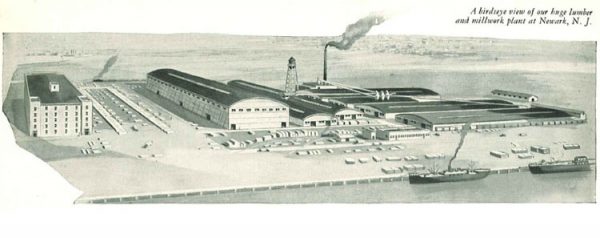
Sears Lumber mill in Newark, New Jersey
If you look carefully at the picture of the plant, you can see the railroad spur just beyond the factory. You had to arrange the transportation for the house kit from the rail yard nearest to your location to the site where the house was to be constructed. After that, you were responsible for preparing the foundation and assembling the house. However, Sears also estimated how much it should cost in your area for you to hire a carpenter or contractor to assemble the house and they would include that cost in the financing if you needed for them to do so. Most Sears stores had building counsellors who would assist you in the process of selecting your home, arranging for the financing, and arranging for the transportation and construction of the house. Whenever I do a civic presentation on Sears homes, someone usually asks what would keep a friend of the Sears home buyer from going to the local lumber yard, buying the lumber, and building their own house using the 75 page instruction book as a guide. No doubt, that happened, but usually it would have been less expensive for the friend to order the kit from Sears because Sears had become the world’s largest lumber retailer. They bought lumber in huge quantities and they owned many of the lumber production facilities, so they could sell the lumber and ship it to the site cheaper than the prospective homeowner could buy it from a local lumber yard and Sears would also provide the financing to boot. Early Sears houses used balloon framing, so the kits were easy to assemble. Sometime in the teens, Sears switched to platform framing for the two story homes. The introduction of drywall in 1917 removed the need for the amateur home builder to hire a plasterer to finish the walls thereby making the erection of a Sears kit house even cheaper and easier. Sears even provided its own brand of drywall with house kits after that.
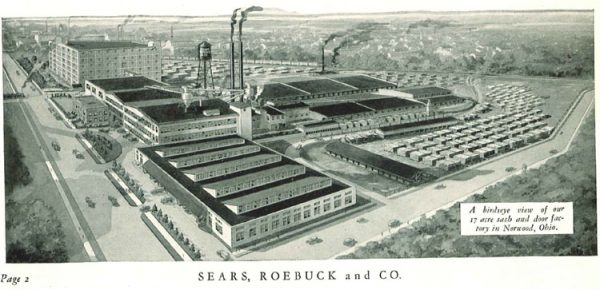
Sears Sash and Door Plant
Using other Sears catalogs, the building counselors also assisted folks with selecting the interior woodwork, cabinets, doors and windows, and gas, electrical, or plumbing fixtures. Most of the doors, windows, cabinets, baseboards, window and door frames, and other finished woodwork items came from the 17 acre Sears Sash and Door Plant at Norwood, Ohio near Cincinnati. Sears also shipped those items to the homeowners by rail car.
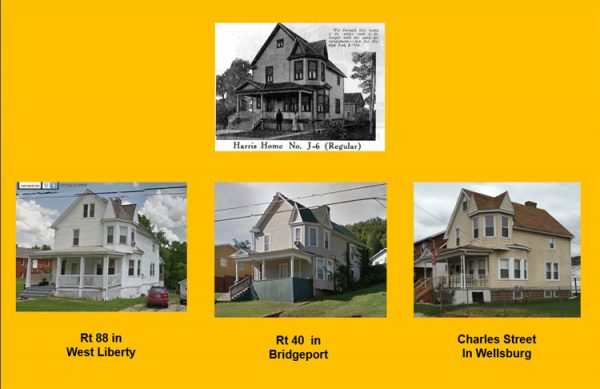
Harris Model 6 houses in our area built around 1914-15. The Model 6 was reintroduced in 1923 as Harris model K-2013
Many of the homes that Sears and Montgomery Ward and Harris Brothers sold were not original designs, but were inspired by or copied from existing home designs. As a result, all three companies often sold similar looking homes through their catalogs. The pictures above show three local examples of a Harris Brothers home called “The Harris Model 6.” The example on the left stood along WV Rt. 88 across from WLU just adjacent to the West Liberty Federated Church building. It was torn down a couple of years ago to make room for an apartment building. The one in the middle is located on the North side of Rt. 40 in Bridgeport a couple of blocks west of the Pizza Hut Restaurant and the example on the right is located in on Charles Street in Wellsburg a couple of blocks south of Krogers. This home appeared in the 1913 – 1915 Harris Brothers Homes catalog, so these three houses were most likely constructed around that time. Sears and Montgomery Ward both also sold a very similar home except that the roof on the turrets on their houses was different and there were some other subtle differences. Over 1000 Harris J-6 houses were built by 1915 even though most people considered the house to be ugly!
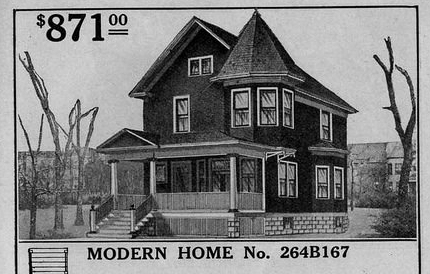
This house was listed in the Sears Modern Homes catalog for 1917. It is almost identical to the Harris Model 6 except for the roof on the turret.
By now, you may be wondering if you or someone who you know may be living in a Sears or Montgomery Ward kit house. To find out, begin your detective work by determining when your house was built. If it was constructed before 1909 or after 1932, it is not a Montgomery Ward house. If it was constructed before 1909 or after 1942, it is not a Sears house. Before you sharp eyed proofreaders start pointing out that I previously stated that Sears published catalogs of homes only through 1940, I will let you know that they continued to ship house kits from their inventory through 1942 even though they were no longer publishing a catalog of homes. While you are tracing back the ownership of your home to see when it was constructed, see if you can find out who provided the first mortgage for the home. If it was Sears, you are probably the owner of a Sears home. If you are not sure when your house was built, check with your County Assessor. If you live in Ohio County, WV, you can do so online at this address: http://www.ohio.wvassessor.com/Search.aspx. Just put your last name into the search box and then click on the link to your property at the bottom of the page. That will bring up a document similar to the one below. Just look under the building data for the year it was built.
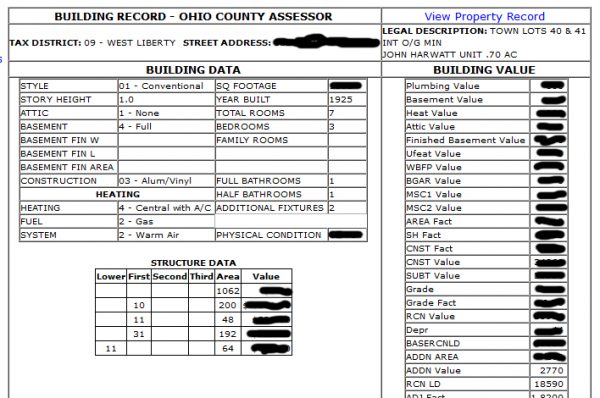
Assessor record screen capture from online search.
Another obvious thing to check out is to see if your house looks like any of the houses in the Sears catalogs. Sears has put a number of the catalog homes online at this link but remember that Sears sold over 400 different home models and most of them are not included on the Sears site. Use your favorite search engine to research Sears or Montgomery Ward houses from the year that your house was built and the two years prior to that. Look for more than one confirmation of the identity of your house because some homeowners have posted incorrectly labelled photos of their homes online. You need to check out the catalog from the year your home was built, but you also need to check out the catalogs from the previous couple of years because a prospective homeowner could also order from those and because the home construction took some time. By the time the house kit was ordered, delivered, and erected, the year of record for when the house was built was often the year after the publication of the catalog from which it was ordered.. Since there are Sears home models that do not appear in any of the catalogs that Sears has online, you may need to use the photo search function on Google or Bing to look for Sears, Wardway, or Harris houses from the year your house was built and the two or three years prior to that. However, finding a house similar to yours in a Sears catalog does not guarantee that yours is a Sears or house. Remember that they sold houses that copied popular styles and so did Montgomery Ward and the other kit house companies, so continue with your research.
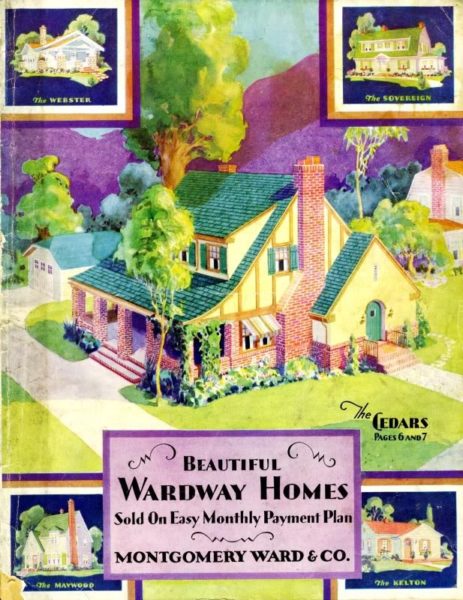
Wardway Homes Catalog Cover
If you find a home similar to yours and the web site provides the name of the home model, then look for it in a Sears home catalog. If you find a house like yours in a Sears Home catalog, check out the floor plan. If it is a two story house, check out the floor plans for both floors. Be sure to remember that the floor plan could be flipped. Go back and reexamine the photo of the three 1914 Harris houses near the beginning of this document. I flipped the picture of the one next to the church in West Liberty because the floor plan had been flipped so the turret was on the left side of the house instead of the right side. One of the early Harris Brothers catalogs actually pictured the Model 6 with the turret on the left. Also, be aware that there were options available sometimes that altered the floorplan. We live in a Sears Starlight house. The starlight was sold with or without an indoor bathroom. Ours had the indoor bathroom, but the floor plan was flipped. Some of the homes had optional items like bay windows or porches. To farther complicate things, the home may have been remodeled over the years thereby altering the floor plan. Some old houses have been remodeled more than once. From the outside, our home does not resemble the original Sears Starlight. A previous homeowner had enclosed the back porch to create a pantry. When we bought the house, the roof structure was bad, so we completely removed the roof including the rafters and replaced them with trusses and an entirely new roof with a different design from the original. While we were replacing the roof, we also enclosed the front porch to create another bedroom and an entryway and we have remodeled the interior. Even if your home has been remodeled, you may still be able to determine if the original floor plan matches the similar home in the catalog.
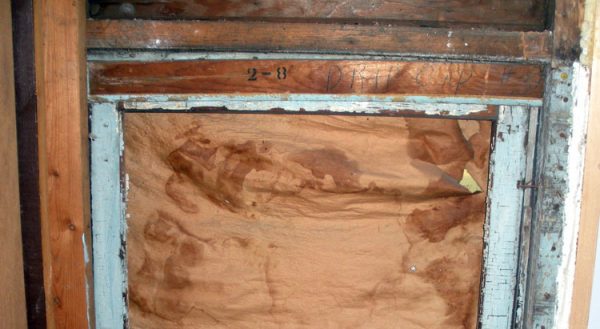
Marked lumber at the Nicodemus house.
A few years ago, we gutted and completely remodeled the part of our house that had originally been an enclosed back porch. When the prior homeowners had remodeled that back porch into a pantry, they had simply walled over some of the original windows without removing them. We stripped off the drywall that the earlier homeowners had installed so that we could insulate that exterior wall. When we did so, we discovered the old windows still intact except for the glass. The photo below shows one of those windows. The number 2 – 8 was stenciled on the drip cap above this window. In addition, it was marked “Drip Cap #3” using a dark blue grease pencil. This drip cap is a great example of marked lumber that you might be able to find in your Sears house. They did not mark every stick of lumber and most of the lumber in the structure of your house is not visible, so you have to be creative in your search for marked lumber. Use a strong flashlight and examine the structure behind your basement steps, Check out your floor joists in the basement if they are visible. Go into the attic and examine any exposed lumber. Any time you do remodeling, keep a sharp eye out for grease pencil markings or stenciled numbers. A couple of our floor joists have grease pencil markings on them, but they are not noticeable without a flashlight. Also keep an eye out for the shipping label. Finding the shipping label is a little like striking gold because it is so unlikely to be in a place that is visible if it even still exists, but some owners of Sears homes have found them, so anything is possible. If your house was constructed within the corporate limits of a city, a building permit may have been required. A few lucky homeowners have been able to find the original building permits which listed Sears as the Architect or as the builder.
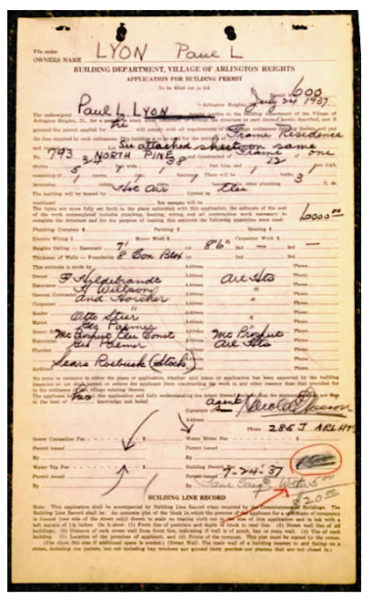
Building permit listing Sears Roebuck as the architect. Photo by Sears Homes of Chicagoland.
When our house was built, it had gas lights. During our remodeling over the years, we have removed all of the original half inch iron pipe that went throughout the house to provide gas for those lights. Unfortunately, none of the lighting or plumbing fixtures were still in the house. However, your home may contain some original Sears hardware. If the house still contains the original cast iron bathtub, it may be marked with a circle containing the letters “SR” for Sears – Roebuck. It is unlikely that any of the original faucets are still in the house, but Sears also marked some of the faucets that they sold with the SR initials.
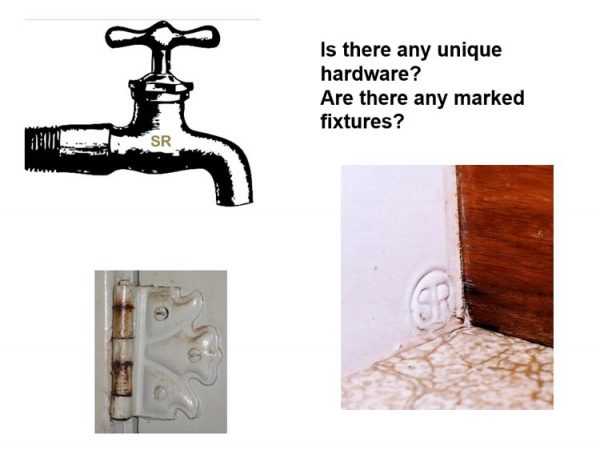
Another bit of evidence can be found by examining the hardware on the kitchen cabinets. The other photo above shows one of the cabinet hinge types that was often used by Sears. Remember that Sears also sold those plumbing fixtures and that cabinet hardware through its catalogs and at its stores, so a Sears bathtub in your home does not make it a Sears home. Sears manufactured their own drywall during part of the time that they sold house kits. If you do any remodeling that requires the removal of some of the original drywall, look at the back side of the drywall to see if it might have been Sears drywall. Anyone could buy Sears drywall, but it is another source of evidence.
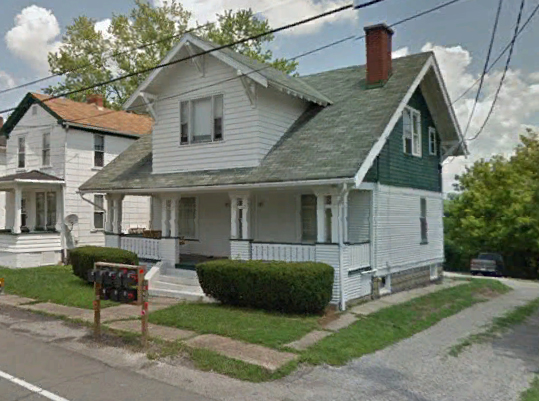
Look for unusual or unique architectural or structural features. The Sears Westly in the picture above is located along WV Rt. 88 near the store in West Liberty. Note the unusual arrangement of the porch posts. They are in groups of three connected by 3 x 3 timbers. That porch post arrangement was used for half a dozen or so Sears Home models.
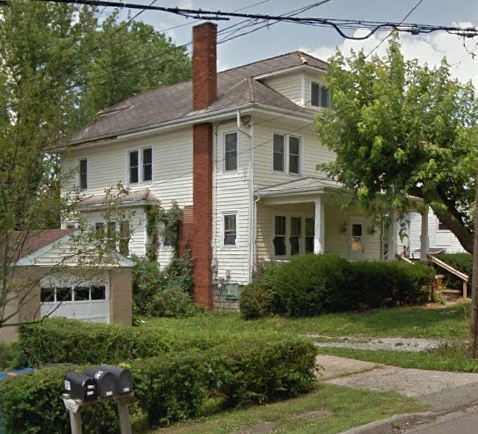
Sears Garfield in West Liberty
Sears foursquare models like the Sears Garfield in the picture above is located on Rt. 88 across from the WLU library. Sears foursquare models like the Garfield often had pairs of windows on the second floor above the porch and several models had triple windows on the porch. Pay special attention to the locations of the chimneys in your house if they are original to the home. Don’t forget that they may be located on the opposite side of the house if the floorplan was flipped. One thing that is usually not changed when a home is remodeled is the location of the chimney.
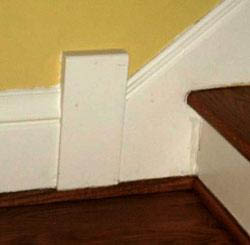
Since Sears houses were usually assembled by inexperienced homeowners, Sears often made it easy to assemble complex joints like the one where the baseboard coming down along the stairway joined the baseboard along the floor. Instead of having the homeowner assemble a complex miter, many Sears homes used a simple rectangular wood block as shown above to make that transition. It was a simple trick that is common in Sears homes, but finding the wood block transition at your staircase does not ensure that yours is a Sears house because that trick was also often used by other builders. Also, remember that some Sears homes did not use the wood block trick to make that joint.
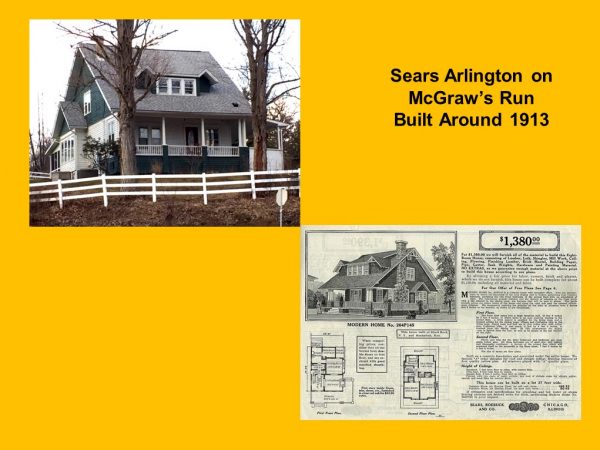
The dormers on the house in the above picture are very unusual. It has a flat dormer flanked by a gabled dormer on each end. This dormer arrangement was almost exclusively used on the Sears Arlington model of home. Unless they were inspired by seeing a Sears Arlington, is very unlikely that anyone building a house would include this dormer system because of the complex construction needed to build it. This home is located on McGraw’s Run road where it intersects with Short McGraw’s Run Road just a few miles from Valley Grove.
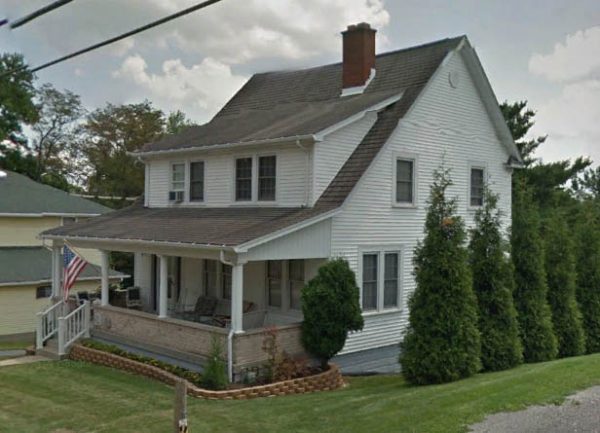
I know this home in West Liberty is a Sears house because an older resident who knew the original owner told me that he remembered when it was built. However, I am still trying to determine the model of this home.
While you are researching your home, you will want to speak with some of the older residents of the community where your house is located. Although I have not been able to find catalog pictures of a couple of Sears homes in West Liberty. One longtime resident recalled when they were built. He informed me that they were Sears houses. He was certain of his information because he actually knew the original owners of those homes. Another home that I had suspected was a Sears house was verified by an individual who made a comment on the West Liberty Historical Society Facebook page. That individual actually posted the name of the model of the house. I had not been certain about the model, but the model that she named fit the house perfectly.
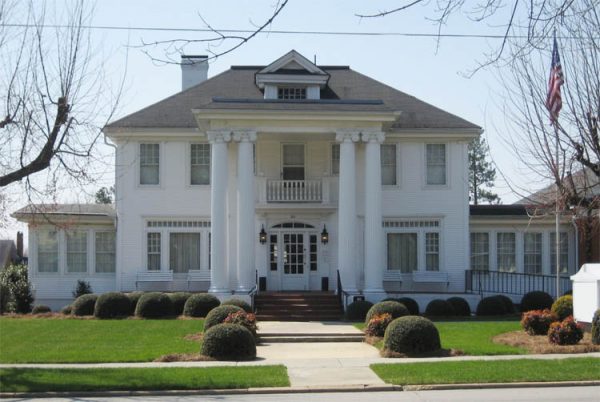
Sears Magnolia
Although Sears and Montgomery Ward sold lots of smaller homes, they also sold some very elaborate houses. The photo above shows a Sears Magnolia. Recently, a Sears Magnolia near Chicago sold for $380,000.00. Have fun researching your home. If you are over 55 years old, keep an eye on the schedule for the West Liberty Community University fall classes. We will be doing a workshop on how to tell if you live in a Sears house as part of that series sometime this fall.
Disclaimer: I have identified the probable models of all of the houses pictured in this document based on the outside appearances of those homes. Since I have not completely researched those houses, some of them may be models of kit homes from other companies or may simply be homes built to look similar to the kit houses. Additional Research would be needed to verify each of them. – Earl


